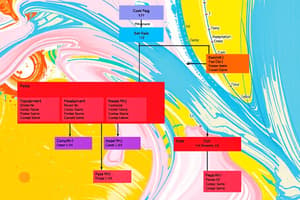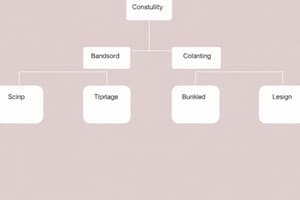Podcast
Questions and Answers
Which statement best describes a candidate key in a relation?
Which statement best describes a candidate key in a relation?
- An attribute that can be used to find the value of another attribute in the relation. (correct)
- The relationship that describes how the value of one attribute may be used to find the value of another attribute.
- A view created and stored on the database, using memory space.
- The data about the data, describing elements such as columns, names, and data types.
What database manipulation language is used for adding, deleting, and modifying data stored in a database?
What database manipulation language is used for adding, deleting, and modifying data stored in a database?
- DDL and DML
- DML (correct)
- DDL
- DCL
What does a materialized view store and how does it differ from a virtual view?
What does a materialized view store and how does it differ from a virtual view?
- A materialized view stores database structures, while a virtual view stores user accounts and permissions.
- A materialized view stores metadata about the data, while a virtual view stores actual data in memory.
- A materialized view stores indexes, while a virtual view stores tuples and elements.
- A materialized view stores actual data, while a virtual view only computes data when accessed. (correct)
What is the purpose of binary search in a database?
What is the purpose of binary search in a database?
What is logical design in database design?
What is logical design in database design?
What is the function of the storage engine in a database system?
What is the function of the storage engine in a database system?
What does a cloud database offer as a service?
What does a cloud database offer as a service?
Which component of a database system compiles queries into low-level instructions?
Which component of a database system compiles queries into low-level instructions?
What type of configuration does parallel computing systems include?
What type of configuration does parallel computing systems include?
What is the purpose of a replicated database?
What is the purpose of a replicated database?
What is the main difference between operational data and analytic data?
What is the main difference between operational data and analytic data?
What is the purpose of a data mart?
What is the purpose of a data mart?
What does ETL stand for in the context of data integration?
What does ETL stand for in the context of data integration?
What does a federated database consist of?
What does a federated database consist of?
What does cardinality represent in a relationship instance?
What does cardinality represent in a relationship instance?
Which type of entity cannot exist without another entity's existence in the database?
Which type of entity cannot exist without another entity's existence in the database?
In database normalization, which form aims for well-formed relations by eliminating redundancy?
In database normalization, which form aims for well-formed relations by eliminating redundancy?
Which join type combines tables without comparing data?
Which join type combines tables without comparing data?
What does the Boyce-Codd Normal Form ensure during normalization?
What does the Boyce-Codd Normal Form ensure during normalization?
Which index type stores column values and row pointers in hierarchy?
Which index type stores column values and row pointers in hierarchy?
What does the term 'Denormalization' in databases involve?
What does the term 'Denormalization' in databases involve?
Which query language retrieves data from the database?
Which query language retrieves data from the database?
Which index structure stores table rows in each bucket?
Which index structure stores table rows in each bucket?
What does the Third Normal Form aim to eliminate during normalization?
What does the Third Normal Form aim to eliminate during normalization?
Which type of join returns matching values?
Which type of join returns matching values?
What does the term 'Normalization' aim to achieve in a database?
What does the term 'Normalization' aim to achieve in a database?
Which type of index structures contains pointers to table blocks?
Which type of index structures contains pointers to table blocks?
What is a Primary Key in a database?
What is a Primary Key in a database?
What does the LIKE operator do in SQL?
What does the LIKE operator do in SQL?
What is the purpose of the HAVING clause in SQL?
What is the purpose of the HAVING clause in SQL?
What does a correlated subquery refer to in SQL?
What does a correlated subquery refer to in SQL?
What is the purpose of entity-relationship modeling?
What is the purpose of entity-relationship modeling?
What is the defining characteristic of an identifying attribute?
What is the defining characteristic of an identifying attribute?
What does a slow query log record in a database?
What does a slow query log record in a database?
What is the primary function of hash functions in databases?
What is the primary function of hash functions in databases?
What is the characteristic of volatile memory?
What is the characteristic of volatile memory?
What best describes the function of storage arrays?
What best describes the function of storage arrays?
What characterizes row-oriented storage in databases?
What characterizes row-oriented storage in databases?
What does dynamic hash function do in databases?
What does dynamic hash function do in databases?
Flashcards are hidden until you start studying
Study Notes
- A Primary Key is a column or group of columns that uniquely identifies a row in a database.
- A constraint is a rule that governs allowable values in a database based on relational and business rules.
- A check constraint specifies an expression on one or more columns that is violated when the expression is false and satisfied when the expression is true or null.
- The LIKE operator performs pattern matching and can be case-insensitive or case-sensitive.
- HAVING is used with GROUP BY to filter results.
- UNION combines two query results into one table.
- An equijoin is a join where the join condition is an equality condition.
- A correlated subquery is a subquery whose WHERE clause references a column from the outer query.
- Flattening is the process of replacing a subquery with an equivalent join.
- A base table is the table specified in the view query's FROM clause.
- A query execution plan converts a SQL query into a sequence of low-level database actions.
- Entity-Relationship modeling is a high-level representation of data requirements.
- A reflexive relationship is a relationship between an entity and itself.
- Cardinality refers to the maxima and minima of relationships and attributes.
- An identifying attribute is a singular, required attribute used to identify an entity.
- A subject area is a group of related entities from a complex model.
- An artificial key is a column or group of columns used as a primary key when no suitable natural key exists.
- Dependency is a relationship between columns where one column depends on another.
- Normal forms are rules for designing tables with less redundancy.
- Volatile memory is memory that is lost when disconnected from power.
- Main memory, also known as random-access memory, is the primary memory used when computer programs execute.
- Flash memory is less expensive and higher capacity than main memory, and it groups data in pages.
- A magnetic disk, also known as a hard-disk drive, is used to share large amounts of data and groups data in sectors.
- Row-oriented storage stores an entire row in one block, while column-oriented storage stores values for a single column only.
- A hash function, such as a modulo function, is used to distribute data evenly across a database.
- Dynamic hash functions automatically allocate more blocks and buckets as needed and distribute rows across all buckets.
- Table clusters interleave rows of two or more tables in the same storage area.
- A single-level index is a file containing column values and pointers to rows containing the column value.
- A multi-column index is an index that contains composite values from all indexed columns.
- A fan-out index is a multi-level index that has a fixed number of index entries per block.
- The branch block is the bottom level of a B-Tree, where all indexed values appear.
- A shard is a subset of table data, usually a subset of rows, stored on different computers in a distributed database.
- A slow query log records all long-running queries submitted to the database.
- A query parser checks queries for syntax errors and converts valid queries to an internal representation.
- A consistent database conforms to all rules at all times.
- A network partition occurs when nodes in a database cannot communicate due to a network error.
- A partition-tolerant database continues to function when a network partition occurs.
- Storage arrays manage replicas internally, without database intervention.
- Type 2 design for slowly-changing dimensions involves adding start and end foreign keys to the fact table.
- An autonomous database operates independently of other participating data sources.
- Heterogeneous databases either run under different database systems or have incompatible schemas.
- A global catalog is a directory of participating database objects such as tables, columns, and indexes.
- Database wrappers convert decomposed queries to the appropriate syntax for each participating database.
- A federated database user mapping associates a federated database user with a participating database user.
Studying That Suits You
Use AI to generate personalized quizzes and flashcards to suit your learning preferences.




